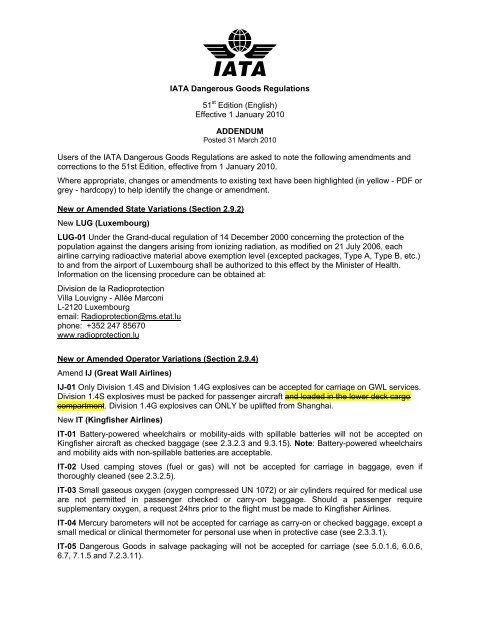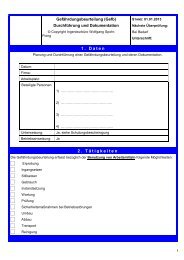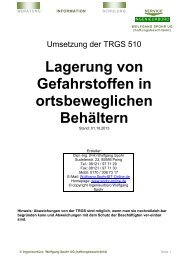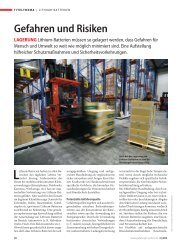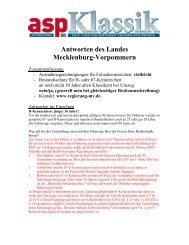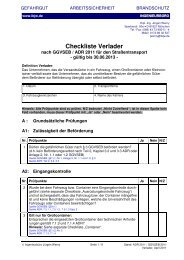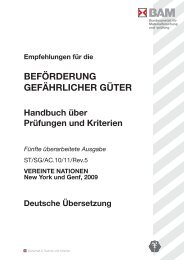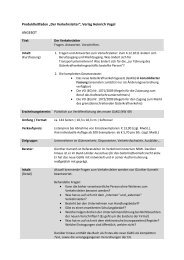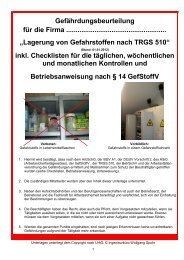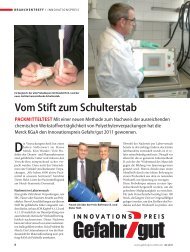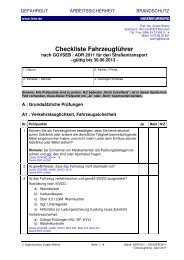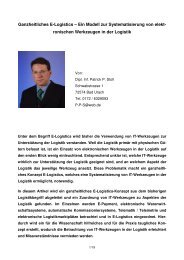IATA Dangerous Goods Regulations 51st Edition (English ... - nifty
IATA Dangerous Goods Regulations 51st Edition (English ... - nifty
IATA Dangerous Goods Regulations 51st Edition (English ... - nifty
Create successful ePaper yourself
Turn your PDF publications into a flip-book with our unique Google optimized e-Paper software.
<strong>IATA</strong> <strong>Dangerous</strong> <strong>Goods</strong> <strong>Regulations</strong><br />
51 st <strong>Edition</strong> (<strong>English</strong>)<br />
Effective 1 January 2010<br />
ADDENDUM<br />
Posted 31 March 2010<br />
Users of the <strong>IATA</strong> <strong>Dangerous</strong> <strong>Goods</strong> <strong>Regulations</strong> are asked to note the following amendments and<br />
corrections to the <strong>51st</strong> <strong>Edition</strong>, effective from 1 January 2010.<br />
Where appropriate, changes or amendments to existing text have been highlighted (in yellow - PDF or<br />
grey - hardcopy) to help identify the change or amendment.<br />
New or Amended State Variations (Section 2.9.2)<br />
New LUG (Luxembourg)<br />
LUG-01 Under the Grand-ducal regulation of 14 December 2000 concerning the protection of the<br />
population against the dangers arising from ionizing radiation, as modified on 21 July 2006, each<br />
airline carrying radioactive material above exemption level (excepted packages, Type A, Type B, etc.)<br />
to and from the airport of Luxembourg shall be authorized to this effect by the Minister of Health.<br />
Information on the licensing procedure can be obtained at:<br />
Division de la Radioprotection<br />
Villa Louvigny - Allée Marconi<br />
L-2120 Luxembourg<br />
email: Radioprotection@ms.etat.lu<br />
phone: +352 247 85670<br />
www.radioprotection.lu<br />
New or Amended Operator Variations (Section 2.9.4)<br />
Amend IJ (Great Wall Airlines)<br />
IJ-01 Only Division 1.4S and Division 1.4G explosives can be accepted for carriage on GWL services.<br />
Division 1.4S explosives must be packed for passenger aircraft and loaded in the lower deck cargo<br />
compartment. Division 1.4G explosives can ONLY be uplifted from Shanghai.<br />
New IT (Kingfisher Airlines)<br />
IT-01 Battery-powered wheelchairs or mobility-aids with spillable batteries will not be accepted on<br />
Kingfisher aircraft as checked baggage (see 2.3.2.3 and 9.3.15). Note: Battery-powered wheelchairs<br />
and mobility aids with non-spillable batteries are acceptable.<br />
IT-02 Used camping stoves (fuel or gas) will not be accepted for carriage in baggage, even if<br />
thoroughly cleaned (see 2.3.2.5).<br />
IT-03 Small gaseous oxygen (oxygen compressed UN 1072) or air cylinders required for medical use<br />
are not permitted in passenger checked or carry-on baggage. Should a passenger require<br />
supplementary oxygen, a request 24hrs prior to the flight must be made to Kingfisher Airlines.<br />
IT-04 Mercury barometers will not be accepted for carriage as carry-on or checked baggage, except a<br />
small medical or clinical thermometer for personal use when in protective case (see 2.3.3.1).<br />
IT-05 <strong>Dangerous</strong> <strong>Goods</strong> in salvage packaging will not be accepted for carriage (see 5.0.1.6, 6.0.6,<br />
6.7, 7.1.5 and 7.2.3.11).
<strong>IATA</strong> <strong>Dangerous</strong> <strong>Goods</strong> <strong>Regulations</strong><br />
51 st <strong>Edition</strong> (<strong>English</strong>) Effective 1 January 2010<br />
ADDENDUM<br />
IT-06 Mercury (UN 2809) or Mercury contained in manufactured articles will not be accepted for<br />
carriage under any circumstances.<br />
IT-07 Hazardous waste as defined by any regulation, will not be accepted for carriage (see Packing<br />
Instruction 622 and 8.1.3.3).<br />
IT-08 The shipper must provide a 24hrs emergency telephone number of a person/agency who is<br />
knowledgeable of the hazards characteristics and the actions to be taken in case of an accident or<br />
incident concerning each of the dangerous goods being transported. This telephone number,<br />
including the country and area code, preceded by the words “Emergency contact” or “24hour number”<br />
must be inserted in the “Additional Handling Information” box of the DGD.<br />
IT-09 <strong>Dangerous</strong> goods as defined by any regulation will not be accepted in AIR MAIL (see 2.4 and<br />
10.2.2).<br />
IT-10 Class – 1 Explosives will not be accepted for carriage except substances and articles of Division<br />
1.4S, UN 0012 or UN 0014 only (see Packing Instruction 130).<br />
IT-11 Division 2.3, Toxic gases will not be accepted for carriage (see Packing Instruction 200 and<br />
206).<br />
IT-12 Class – 4 Flammable Solids will not be accepted for carriage.<br />
IT-13 Class – 7 Radioactive material will not be accepted for carriage (see 10.10.2).<br />
Amend KZ (Nippon Cargo Airlines)<br />
KZ-06 In the case of a transhipment, a photocopy of the Shipper's Declaration will not be accepted.<br />
Two copies of the Shipper's Declaration must be forwarded with the shipment (see 8.1.2.3). Not used.<br />
Amend MN (Comair Pty Limited)<br />
Add new:<br />
MN-04 Bicycle Inflation Pumps filled with Div 2.2 Carbon Dioxide non-flammable gas will be accepted<br />
for transportation as checked baggage only. The maximum amount per passenger is limited to four<br />
16 g cartridges. Cartridges larger than 16 g will not be permitted for carriage. This is outside the<br />
Company policy as specified in MN-01.<br />
Section 2<br />
Pg. 12 – Amend 2.3.2 as shown:<br />
2.3.2 <strong>Goods</strong> Acceptable with Operator Approval, as Checked Baggage Only<br />
The following dangerous goods, as listed in 2.3.2.1 through 2.3.2.4 2.3.2.5, are permitted on aircraft<br />
as checked baggage only and with the approval of the operator(s).<br />
Pg. 12 – Amend 2.3.2.2 and 2.3.2.3 as shown:<br />
2.3.2.2 Wheelchairs/Mobility Aids with Non-spillable Batteries<br />
Battery-powered wheelchairs or other battery-powered similar mobility aids for use by passengers<br />
whose mobility is restricted by either a disability, their health or age, or a temporary mobility problem<br />
(e.g. broken leg), with non-spillable batteries, (see Packing Instruction 806 and Special Provision<br />
A67), which comply with Special Provision A67 or the vibration and pressure differential tests of<br />
Packing Instruction 806 provided the battery terminals are protected from short circuits, e.g. by being<br />
enclosed within a battery container, and the battery is securely attached to the wheelchair or mobility<br />
aid (see 9.3.15.4 and Figure 9.3.G). Operators must ensure that wheelchairs or other batterypowered<br />
mobility aids are carried in such a manner so as to prevent unintentional operation and that<br />
the wheelchair/mobility aid is protected from being damaged by the movement of baggage, mail,<br />
stores or cargo. It is recommended that passengers make advance arrangements with each operator.<br />
06/04/10 Page 2/8
<strong>IATA</strong> <strong>Dangerous</strong> <strong>Goods</strong> <strong>Regulations</strong><br />
51 st <strong>Edition</strong> (<strong>English</strong>) Effective 1 January 2010<br />
ADDENDUM<br />
2.3.2.3 Wheelchairs/Mobility Aids with Spillable Batteries<br />
2.3.2.3.1 Battery-powered wheelchairs or other battery-powered similar mobility aids for use by<br />
passengers whose mobility is restricted by either a disability, their health or age, or a temporary<br />
mobility problem (e.g. broken leg), with spillable batteries, provided that the wheelchair or mobility aid<br />
can be loaded, stowed, secured and unloaded always in an upright position and that the battery is<br />
disconnected, the battery terminals are protected from short circuits, e.g. by being enclosed within a<br />
battery container, and the battery is securely attached to the wheelchair or mobility aid. Operators<br />
must ensure that wheelchairs or other battery-powered mobility aids are carried in such a manner so<br />
as to prevent unintentional operation and that the wheelchair/mobility aid is protected from being<br />
damaged by the movement of baggage, mail, stores or cargo. If the wheelchair or mobility aid cannot<br />
be loaded, stowed, secured and unloaded always in an upright position, the battery must be removed<br />
and the wheelchair or mobility aid may then be carried as checked baggage without restriction. The<br />
removed battery must be carried in strong, rigid packagings as follows:<br />
(a) packagings must be leak-tight, impervious to battery fluid and be protected against upset by<br />
securing to pallets or by securing them in cargo compartments using appropriate means of<br />
securement (other than by bracing with freight or baggage) such as by use of restraining straps,<br />
brackets or holders;<br />
(b) batteries must be protected against short circuits, secured upright in these packagings and<br />
surrounded by compatible absorbent material sufficient to absorb their total liquid contents; and<br />
(c) these packagings must be marked “BATTERY, WET, WITH WHEELCHAIR” or “BATTERY, WET,<br />
WITH MOBILITY AID” and be labelled with the “Corrosive” label (see Figure 7.3.V) and with the<br />
“Package Orientation” label (see Figures 7.4.E and 7.4.F).<br />
2.3.2.3.2 The pilot-in-command must be informed of the location of a wheelchair or mobility aid with<br />
an installed battery or the location of a packed battery. It is recommended that passengers make<br />
advance arrangements with each operator; also that batteries which are spillable should be fitted with<br />
spill-resistant vent caps when feasible (see 9.3.15.4 and Figure 9.3.H).<br />
Pg. 12 – Add new 2.3.2.4 as follows:<br />
2.3.2.4 Wheelchairs/Mobility Aids with Lithium Batteries<br />
2.3.2.4.1 Lithium-ion battery powered wheelchairs or other similar mobility aids for use by passengers<br />
whose mobility is restricted by either a disability, their health or age, or a temporary mobility problem<br />
(e.g. broken leg), subject to the following conditions:<br />
(a) the batteries must be of a type which meets the requirements of each test in the UN Manual of<br />
Tests and Criteria, Part III, section 38.3;<br />
(b) battery terminals are protected from short circuits, e.g. by being enclosed within a battery<br />
container, and the battery is securely attached to the wheelchair or mobility aid;<br />
(c) the operator(s) must ensure that such mobility aids are carried in a manner so as to prevent<br />
unintentional activation and that they are protected from being damaged by the movement of<br />
baggage, mail, stores or other cargo; and<br />
(d) the pilot-in-command must be informed of the location of the mobility aid.<br />
It is recommended that passengers make advance arrangements with each operator.<br />
Pg. 12 – Revise existing 2.3.2.4 to become 2.3.2.5<br />
06/04/10 Page 3/8
<strong>IATA</strong> <strong>Dangerous</strong> <strong>Goods</strong> <strong>Regulations</strong><br />
51 st <strong>Edition</strong> (<strong>English</strong>) Effective 1 January 2010<br />
ADDENDUM<br />
Pg. 14 – Amend Table 2.3.A as follows:<br />
NO YES NO YES NO<br />
Wheelchairs or other battery-powered mobility devices with non-spillable<br />
batteries (see which comply with Packing Instruction 806 and Special Provision A67),<br />
provided the battery terminals are insulated to prevent accidental short circuits, e.g. by<br />
being enclosed within a battery container, and the battery is securely attached to the<br />
wheelchair or mobility aid. Operators must ensure that wheelchairs or other batterypowered<br />
mobility aids are carried in such a manner so as to prevent unintentional<br />
operation and that the wheelchair/mobility aid is protected from being damaged by the<br />
movement of baggage, mail, stores or cargo.<br />
NO YES NO YES YES Wheelchairs or other battery-powered mobility devices with spillable<br />
batteries or with lithium-ion batteries. (See 2.3.2.3 and 2.3.2.4 for details.)<br />
Section 4<br />
Pg. 127/128 – Table 4.1.A: Revise Division 4.1 General entries as shown:<br />
Class or Division<br />
General entries<br />
Subsidiary<br />
Risk<br />
UN or ID<br />
No.<br />
Proper Shipping Names<br />
(Note: The is not part of the proper shipping name)<br />
4.1 8 3180 Flammable solid, corrosive, inorganic, n.o.s.<br />
8 2925 Flammable solid, corrosive, organic, n.o.s.<br />
3178 Flammable solid, inorganic, n.o.s.<br />
1325 Flammable solid, organic, n.o.s.<br />
3176 Flammable solid, organic, molten, n.o.s.<br />
5.1 3097 Flammable solid, oxidizing, n.o.s.<br />
6.1 3179 Flammable solid, toxic, inorganic, n.o.s.<br />
6.1 2926 Flammable solid, toxic, organic, n.o.s.<br />
3181 Metal salts of organic compounds, flammable, n.o.s.<br />
3175 Solids containing flammable liquid, n.o.s.<br />
Pg. 211 – 4.2: Revise the proper shipping name for UN 3468 to read:<br />
Hydrogen in a metal hydride storage system<br />
Pg. 225 – 4.2: Revise ERG Code for UN 1230, Methanol to be 3L<br />
Pg. 240 – 4.2: Revise the entry for UN 3356 as shown:<br />
UN/<br />
ID<br />
no.<br />
Proper Shipping Name/Description<br />
Class<br />
or<br />
Div.<br />
(Sub<br />
Risk) Hazard Label(s) PG<br />
EQ<br />
see<br />
2.7<br />
Passenger and Cargo Aircraft<br />
Pkg<br />
Inst<br />
Ltd Qty<br />
Max Net<br />
Qty/Pkg<br />
Pkg<br />
Inst<br />
Max<br />
Net<br />
Qty/Pk<br />
g<br />
Cargo Aircraft<br />
Only<br />
Pkg<br />
Inst<br />
Max Net<br />
Qty/Pkg<br />
A B C D E F G H I J K L M N<br />
3356 Oxygen generator, chemical †<br />
(including when contained in associated<br />
equipment e.g. passenger service units<br />
(PSUs), protective breathing equipment<br />
(PBE), etc.<br />
5.1 Oxidizer II E0 Forbidden Forbidden 523 25 kg G<br />
25 kg<br />
S.P.<br />
see<br />
4.4<br />
A1<br />
A111<br />
A116<br />
A144<br />
ERG<br />
Code<br />
5L<br />
06/04/10 Page 4/8
<strong>IATA</strong> <strong>Dangerous</strong> <strong>Goods</strong> <strong>Regulations</strong><br />
51 st <strong>Edition</strong> (<strong>English</strong>) Effective 1 January 2010<br />
ADDENDUM<br />
Table 4.2 revise the following entries as shown:<br />
Pg. 164<br />
tert-Butyl peroxyacetate, > 52% and < 77%, when with >23% diluent Type B<br />
Pg. 173<br />
3-Chloroperoxybenzoic acid, > 57% and < 86%, when with ≥ 14% inert solid<br />
Pg. 183<br />
Diacetone alcohol peroxides, > 57% in solution with > 9% hydrogen peroxide, < 26% diacetone alcohol and<br />
< 9% water; total active oxygen content > 10% by weight<br />
Pg. 184<br />
Dibenzoyl peroxide, > 77% and < 94%, when with ≥6% water<br />
Pg. 202<br />
Formaldehyde solution with ≥ 10% but < 25% formaldehyde, see Aviation regulated liquid, n.o.s.* †<br />
(UN 3334)<br />
UN 3412 Formic acid<br />
with ≥ 5% but < 10% acid by weight<br />
Pg. 232<br />
UN 2031 Nitric acid<br />
other than red fuming, with > 20% but < 65% nitric acid<br />
Pg. 237<br />
UN 0266 Octol<br />
dry or wetted with < 15% water, by weight<br />
UN 0266 Octolite<br />
dry or wetted with < 15% water, by weight<br />
Pg. 247<br />
UN 0154 Picric acid<br />
dry or wetted with < 30% water, by weight<br />
Pg. 252<br />
UN 1848 Propionic acid<br />
with ≥ 10% but < 90% acid by weight<br />
Pg. 271<br />
UN 0209 TNT<br />
dry or wetted with < 30% water, by weight<br />
Pg. 276<br />
UN 0214 Trinitrobenzene<br />
dry or wetted with < 30% water, by weight<br />
UN 0215 Trinitrobenzoic acid<br />
dry or wetted with < 30% water, by weight<br />
UN 0154 Trinitrophenol<br />
dry or wetted with < 30% water, by weight<br />
Pg. 277<br />
UN 0209 Trinitrotoluene<br />
dry or wetted with < 30% water, by weight<br />
Pg. 278<br />
UN 3370 Urea nitrate<br />
with > 10% but < 20% water, by weight<br />
06/04/10 Page 5/8
<strong>IATA</strong> <strong>Dangerous</strong> <strong>Goods</strong> <strong>Regulations</strong><br />
51 st <strong>Edition</strong> (<strong>English</strong>) Effective 1 January 2010<br />
ADDENDUM<br />
Section 5<br />
Packing Instruction 523 – Add “FX-13 into operator variations.<br />
Section 9<br />
9.3.15 Loading of Wheelchairs or other Battery Operated Mobility Aids as Checked Baggage<br />
9.3.15.1 Wheelchairs or other battery-powered mobility aids with spillable batteries, being carried with the<br />
approval of the operator as checked baggage, must be loaded as follows:<br />
(a) if the wheelchair or mobility aid is loaded, stowed, secured and unloaded always in an upright position, the<br />
battery must be disconnected, the battery terminals insulated to prevent accidental short circuits e.g. by being<br />
enclosed within a battery container, and the battery securely attached to the wheelchair or mobility aid; or<br />
(b) if the wheelchair or mobility aid cannot be loaded, stowed, secured and unloaded always in an upright<br />
position, the battery must be removed and the wheelchair or mobility aid may then be carried as checked<br />
baggage without restriction. The removed battery must be carried in strong, rigid packagings as follows:<br />
• packagings must be leak-tight, impervious to battery fluid and be protected against upset by securing<br />
to pallets or by securing them in cargo compartments using appropriate means of securement (other<br />
than by bracing with freight or baggage) such as by use of restraining straps, brackets or holders;<br />
• batteries must be protected against short circuits, secured upright in these packagings and<br />
surrounded by compatible absorbent material sufficient to absorb their total liquid contents; and;<br />
• these packagings must be marked “BATTERY, WET, WITH WHEELCHAIR” or “BATTERY, WET,<br />
WITH MOBILITY AID” and be labelled with the “Corrosive” label (see Figure 7.3.U), and with the<br />
“Package Orientation” label (see Figure 7.4.E and Figure 7.4.F).<br />
9.3.15.2 The pilot-in-command must be informed of the location of a wheelchair or mobility aid with an<br />
installed battery or the location of a packed battery. It is recommended that passengers make advance<br />
arrangements with each operator, also that batteries which are spillable should be fitted with spill-resistant<br />
vent caps when feasible.<br />
9.3.15.3 Wheelchairs or other battery-powered mobility aids with non-spillable batteries, being carried with the<br />
approval of the operator as checked baggage only, must be loaded with the battery terminals insulated to<br />
prevent accidental short circuits, e.g. by being enclosed within a battery container, and the battery securely<br />
attached to the wheelchair or mobility aid.<br />
9.3.15.4 Lithium-ion battery powered wheelchairs or other similar mobility aids for use by passengers whose<br />
mobility is restricted by either a disability, their health or age, or a temporary mobility problem (e.g. broken<br />
leg), subject to the following conditions:<br />
(a) the batteries must be of a type which meets the requirements of each test in the UN Manual of Tests and<br />
Criteria, Part III, section 38.3;<br />
(b) battery terminals are protected from short circuits, e.g. by being enclosed within a battery container, and<br />
the battery is securely attached to the wheelchair or mobility aid;<br />
(c) the operator(s) must ensure that such mobility aids are carried in a manner so as to prevent unintentional<br />
activation and that they are protected from being damaged by the movement of baggage, mail, stores or<br />
other cargo; and<br />
(d) the pilot-in-command must be informed of the location of the mobility aid.<br />
It is recommended that passengers make advance arrangements with each operator.<br />
9.3.15.5 Operators must ensure that wheelchairs or other battery-powered mobility aids are carried in such a<br />
manner so as to prevent unintentional operation and that the wheelchair/mobility aid is protected from being<br />
damaged by the movement of baggage, mail, stores or cargo.<br />
9.3.15.4 9.3.15.6 To assist the handling of wheelchairs and mobility aids with batteries, Figure 9.3.H shows an<br />
example of a label which may be used to assist in identifying whether or not a wheelchair has had the battery<br />
06/04/10 Page 6/8
<strong>IATA</strong> <strong>Dangerous</strong> <strong>Goods</strong> <strong>Regulations</strong><br />
51 st <strong>Edition</strong> (<strong>English</strong>) Effective 1 January 2010<br />
ADDENDUM<br />
removed. The label is in two parts; Part A remains with the wheelchair and indicates whether or not the battery<br />
has been removed. In the particular case where the battery is separated from the wheelchair, Part B may be<br />
used to assist in identifying the battery and also in reconciling the battery and its wheelchair.<br />
FIGURE 9.3.H<br />
Battery-powered Wheelchair and Mobility Aid label (9.3.15.4 9.3.15.6)<br />
Appendix D.1<br />
Amend Information for Algeria:<br />
Direction de l'aviation civile et Météorologie (DACM)<br />
01, Chemin Ibn Badiss El-Mouiz El Biar<br />
Algiers<br />
ALGERIA<br />
Tel: +213 21 92 98 85 to 89<br />
Fax: +213 21 92 98 94<br />
Telex: 66129/ 66063/66137<br />
Amend Information for United Kingdom<br />
Civil Aviation Authority<br />
<strong>Dangerous</strong> <strong>Goods</strong> Office<br />
1W, Aviation House<br />
Gatwick Airport<br />
West Sussex<br />
UNITED KINGDOM<br />
RH6 OYR<br />
Tel: +44 (1293) 573 800<br />
Fax: Fax: +44 (1293) 573 991<br />
Telex: 878753<br />
email: dgo@srg.caa.co.uk dgo@caa.co.uk<br />
Appendix E.2<br />
Pg. 789<br />
GH Package & Product Testing<br />
2602 West Townley Avenue, Suite 5<br />
Phoenix<br />
Arizona<br />
U.S.A.<br />
85021<br />
Tel: +1 (602) 678 5755<br />
Fax: Fax: +1 (602) 870 3776<br />
GH Package/Product Testing and Consulting of Arizona, Inc.<br />
335 W. Melinda Lane 21609 N. 12th Ave., Suite 300<br />
Phoenix<br />
Arizona<br />
USA<br />
85027<br />
Tel: +1 (623) 869 8008<br />
Fax: Fax: +1 (623) 869 8003<br />
email: ghtesting@aol.com<br />
06/04/10 Page 7/8
<strong>IATA</strong> <strong>Dangerous</strong> <strong>Goods</strong> <strong>Regulations</strong><br />
51 st <strong>Edition</strong> (<strong>English</strong>) Effective 1 January 2010<br />
ADDENDUM<br />
GH Package & Product Testing and Consulting, Inc.<br />
325 Commercial Drive 4090 Thunderbird Lane<br />
Fairfield<br />
Ohio<br />
USA<br />
45014<br />
Tel: +1 (513) 870 0080<br />
Fax: Fax: +1 (513) 870 0017<br />
Appendix F.3<br />
Pg. 815<br />
Alan E. Hollander and Associates Inc.<br />
1661 East Chapman Avenue, Suite 1D 2C<br />
Fullerton<br />
California<br />
UNITED STATES 92831<br />
Tel: +1 (714) 992 2430<br />
Fax: +1 (714) 992 4052<br />
E-mail: a.e.hollander@worldnet.att.net a.e.hollander@att.net<br />
Appendix F.4<br />
Pg. 817<br />
Peter East Associates Ltd<br />
504 Centennial Park<br />
Centennial Avenue<br />
Elstree<br />
Herts WD6 3FG<br />
Tel: + 44 (0) 20 8953 6721<br />
Fax: + 44 (0) 20 7998 8798<br />
e-mail: info@petereast.com<br />
06/04/10 Page 8/8


